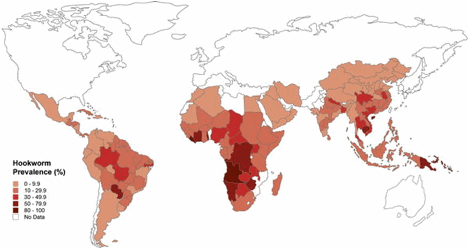
TM
Affected Areas
The prevalence of Hookworm infection around the world is difficult to gauge. Many of the numbers reported are ‘survey’ estimates of endemic areas since there is no centralized worldwide surveillance to determine prevalence and global distribution.
The major etiology of hookworm infection is N. Americanus which is found the Americas, sub-Saharan Africa, and Asia [5]. A. duodenale is found in more scattered focal environments, namely Europe and the Mediterranean. Most infected individuals are concentrated in sub-Saharan Africa (198 million) and East Asia/the Pacific Islands (149 million). Other affected regions include: South Asia (50 million), Latin America and the Caribbean (50 million), South Asia (59 million), Middle East/North Africa (10 million)[6].
Here are some recent findings on prevalence rates in endemic regions.
Darjeeling, Hooghly District, West Bengal, India [7]
• 42.8% infection rate of predominantly N. Americanus although with some A. Duodenale infection
• Hookworm infection load and degree of anemia in the mild range
Xiulongkan Village, Hainan Province, China [8]
• 60% infection rate of predominantly N. Americanus
• Prevalence increased with age (plateau of about 41 years)
• Women had higher prevalence rates than men
Hoa Binh, Northwest Vietnam [9]
• 52% of 526 households tested were infected
• Species could not be identified (N. Americanus in more than 95% of hookworm larvae)
Minas Gerais, Brazil [10]
• 62.8% infection rate of predominantly N. Americanus
KwaZulu-Natal, South Africa [11]
• Inland areas had a prevalence rate of 9.3% of N. Americanus
• Coastal plain areas had a prevalence rate of 62.5% of N. Americanus
The table below shoes some prevalence rates of Hookworm that have been measured through survey data in endemic regions around the world:

REF: Hotez P, Bethony J, Bottazzi ME, Brooker S, Buss P (2005) Hookworm: “The Great Infection of Mankind”. PLoS Med 2(3): e67
The table below form the WHO, portrays hookworm (soil-transmitted helminth (STH)) infections in the tropical and subtropical areas:

Ref: World Health Organization 2006